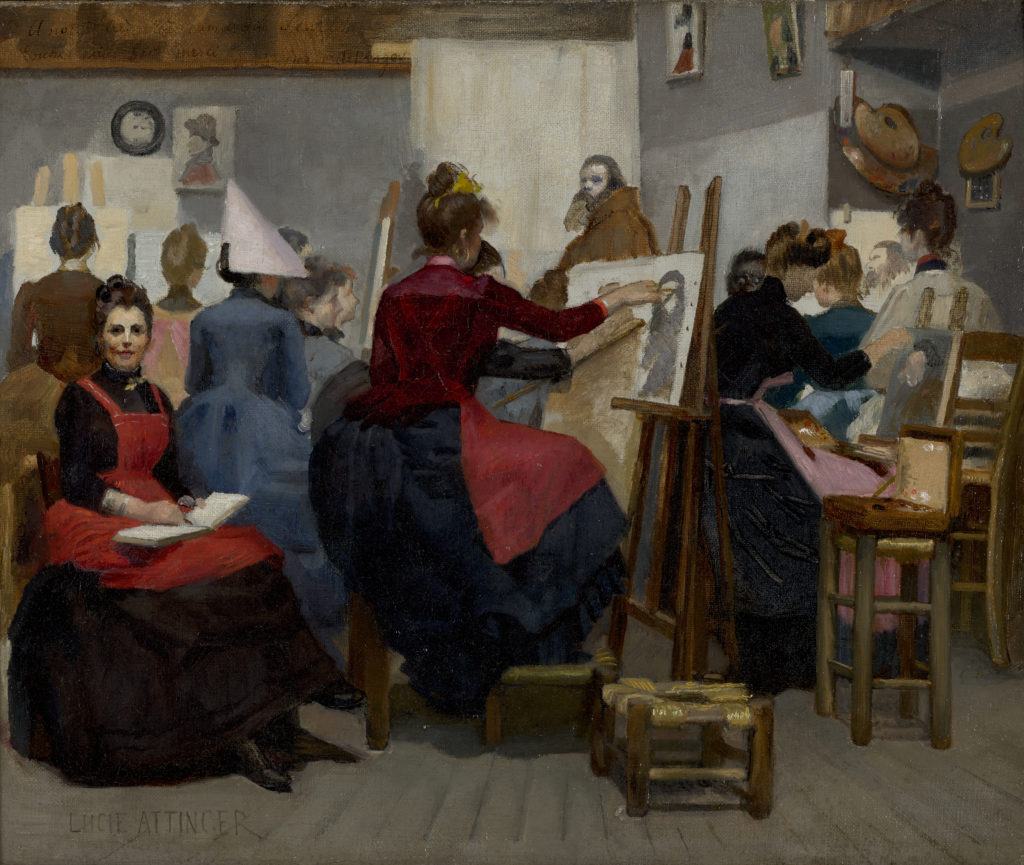Mon Atelier (My Studio) (work of art)
Artwork Info
Key Ideas
- This work depicts an all-women painting class at a time when most art schools did not allow women to attend. It is a rare example of a painting that features women artists practicing professionally during the 19th century.
- Lucie Attinger was a Swiss painter and illustrator who attended the Académie Julian in Paris.
- This is one of only two known paintings that depict an all-women art class at the Académie Julian.
- The Académie Julian was one of the few schools that allowed women and men to have equal access to art education and training.
- Attinger used alizarin red for the blouse of the woman at center. Alizarin was invented in 1868. It was the first synthetic (human-made) dye to replicate a natural dye, specifically madder red from the madder plant. Alizarin is the product of modern chemistry and the Industrial Revolution.
Learn More
The woman shown wearing a red apron (and looking directly at the viewer) is Lucie Attinger, the artist who created this painting. She was a Swiss painter and illustrator. Attinger studied under the artists Georges Grisel and Auguste Bachelin in Switzerland before she moved to Paris to attend the Académie Julian. This scene shows an all-women painting class at the Académie Julian in Paris. It was one of the few schools that admitted women and gave them the same access that men had to art education and training. The Académie Julian was the leading international school for women artists at the time.
Attinger exhibited her work at the Paris Salon only once, with this painting, in 1889. This work is an example of the success that the students of the Académie Julian could achieve. Attinger’s painting is a rare document of women artists overcoming barriers and practicing professionally. It is one of two known artworks that depict an all-women painting class at the Académie Julian. The other work, titled In the Studio, was painted by Mariya Bashkirtseva (also known as Marie Bashkirtseff) in 1881. These two works of art offer insight into the training of women artists at the end of the 19th century. Historic systems of exclusion of women artists have led to them being underrepresented in museum collections. This painting is one of three works by women artists in the European collection at the NCMA.
The inscription at the upper left side of this painting is an element that makes Attinger’s work unique. It indicates that the artist created the painting as a gift to a professor. The parts that can be read translate as follows: A notre très chère … / Encore mille fois merci … Attinger (To our very dear … / Thank you again a thousand times … Attinger).
Attinger used alizarin red to paint the central figure’s blouse. Alizarin was invented in 1868. It was a product of modern chemistry and the Industrial Revolution. Alizarin is made from coal tar, a byproduct of the processing of coal. In the 19th century, coal tar was used to create products like dyes and medications. Alizarin was the first synthetic (human-made) dye to replicate a natural dye, specifically madder red from the madder plant. The name “alizarin” comes from the Arabic word for madder (alizari). Alizarin was brighter and cheaper to make than madder red. Madder had been used since ancient times to create high-quality red dye and paint. The widespread cultivation and trade of madder collapsed quickly as alizarin became popular with painters. Alizarin was called “the color of the decade” in the 1870s. It was an essential part of new art forms such as impressionism.
Additional Resources
Resources for Teachers
- Watch a video about the Académie Julian in the late 19th century and discover how the school influenced women artists internationally.
- Read more about Lucie Attinger.
- Read an article about the ways in which the Industrial Revolution changed art.
Resources for Students
- View another painting of an all-women art class at the Académie Julian.
- Look closely at a photograph of an art class at the Académie Julian.
- Watch a video about the Industrial Revolution in Europe.

